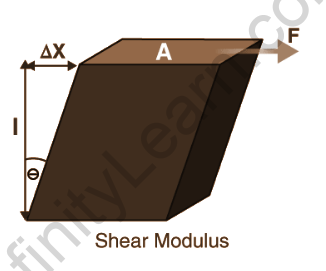Table of Contents
Dimensions of Modulus Of Rigidity: If a body has a distinct shape and size, it is said to be rigid. The solid bodies we observe around us are not completely rigid. When applied with an external force, they can be compressed, stretched, and bent. Objects deform when an external force is applied.
Some objects have a tendency to revert to their original shapes. Stress is really the internal force that acts per unit area of the body to return it to its original shape. The strain has been defined as the ratio of the change in any dimension produced by the body to the original dimension.
In science, the rigidity modulus, as well known as shear modulus, is really a material property with a value equal to the shear stress divided by the shear strain. The shear modulus is just one of many quantities used to determine the stiffness of materials.
Whenever a solid encounters a force parallel to one of its surfaces while its opposing face encounters an opposite force, the shear modulus changes (such as friction). A rectangular prism, for example, will twist into a parallelepiped.
Once tested in different directions, wood, paper, and virtually all single crystals, such as anisotropic materials, exhibit a different material response to stress or strain. In this particular instance, instead of a single scalar value, the full tensor term of the elastic constants may be required.

The shear modulus’s general formula is τ = γ×G
in which the shear stress τ is in a given element, the unit of force divided by the area γ, the shear strain has no unit, and the shear modulus is G, which has the unit of force divided by the area. Shear modulus, like the modulus of elasticity, is yet another form of generalised Hook’s law.
A tensile stress test can be used to calculate the modulus of rigidity, which is plotted as stress versus strain. The gradient of the line is equivalent to the rigidity modulus. Because shear force over an area equals shear stress, and strain equals the change in length divided by initial length.

Modulus of Rigidity Dimensional Formula
The dimensional formula of modulus of rigidity can be represented as:
[M1 L-1 T-2]
Here,
- M = Mass
- L = Length
- T = Time
Modulus of Rigidity Derivation
We have, Modulus of Rigidity (μ) = shear stress × [shear strain]-1 . . . . (1)
As because, strain = ΔL/L = Dimensionless Quantity . . . . (2)
Similarly, Stress = Force × [Area]-1 . . . . . (3)
Now, the dimensional formula of,
Area = [M0 L2 T0] . . . . (4)
Force = [M1 L1 T-2] . . . . . (5)
When substituting equation (4) and (5) in equation (3) we get,
Stress = [M1 L1 T-2] × [M0 L2 T0]-1
Thus, the dimensions of stress = [M1 L-1 T-2] . . . . (6)
When substituting equation (2) and (6) in equation (1) we get,
Modulus of Rigidity (μ) = shear stress × [shear strain]-1 or μ = [M1 L-1 T-2] × [M0 L0 T0]-1 = [M1 L-1 T-2].
Hence, the Modulus of Rigidity has been dimensionally represented as [M1 L-1 T-2].

Frequently Asked Questions (FAQs)
What is modulus of rigidity and its SI unit?
Modulus of rigidity (shear modulus) measures a material's resistance to shear deformation. Its SI unit is the pascal (Pa).
What will be the modulus of rigidity?
Modulus of rigidity is the ratio of shear stress to shear strain in a material, denoted by the symbol G.
What is modulus of rigidity formula dimensions?
The dimensions of modulus of rigidity are ML −1T −2, the same as pressure or stress.
What is the formula for Young's modulus of rigidity?
Young’s modulus is different from modulus of rigidity, but the relationship is E=2G(1+ν), where ν is Poisson's ratio.
What is the unit and dimension of modulus?
The unit of modulus (rigidity or elasticity) is pascal (Pa), and its dimensions are ML −1 T −2.
Is modulus of rigidity denoted by N?
No, modulus of rigidity is denoted by G, while N (newton) is a unit of force.
What is the modulus of rigidity constant?
The modulus of rigidity constant, G, varies by material and defines its ability to resist shear deformation.






